If you own a betta fish or are looking to get one Snails, you have likely come across information about their temperament.
Betta splendens, also known as the Siamese fighting fish, has a well-earned reputation for not exactly being the easiest of roommates.
Their nature makes it difficult to find suitable tank mates, and while this fish is often kept as a single specimen, they can coexist with other species.
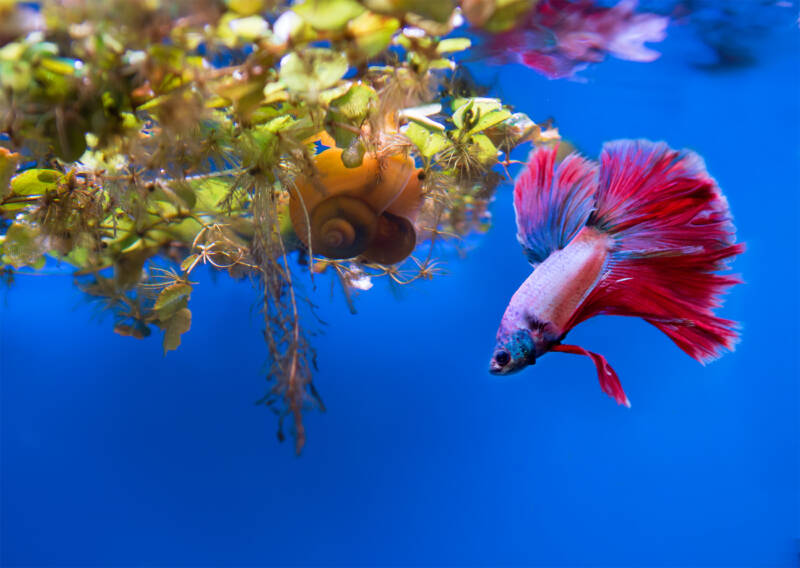
Of the freshwater species that are suitable to house with a betta, snails are a popular choice because they generally mind their own business and serve as valuable members of the tank cleanup crew.
Below, we discuss the ideal aquarium setup for a betta living with a snail. We also provide our list of favorite snail species for you to consider as your betta’s tank mate.
[toc]
Ideal Tank Setup
Having the ideal tank setup can go a long way toward keeping the peace between your betta and your snail. Tank size, layout, and water parameters are all important.
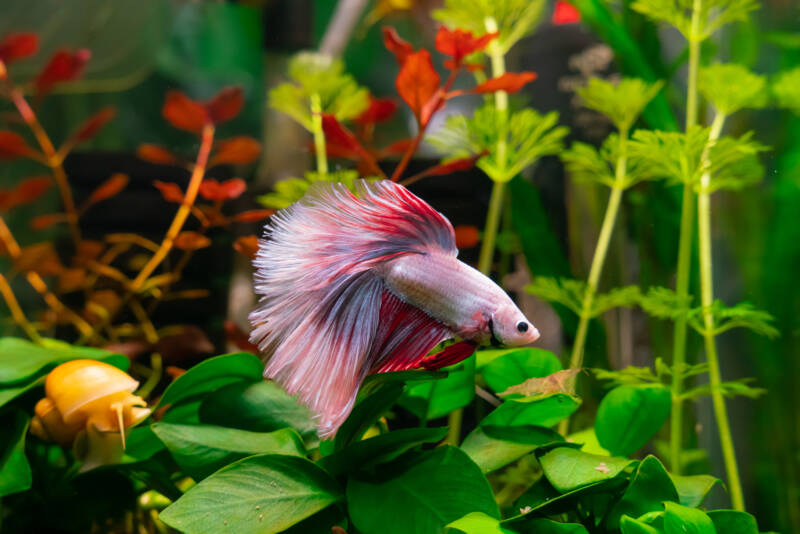
Tank Size
A single betta fish can live well in a tank as small as five gallons (19 l). However, once you begin adding other tank mates, even ones as docile as snails, you need to increase the size to at least 10 gallons (38 l).
This will give your fish and snails plenty of space to roam, and they will be less likely to come into conflict.
Water Parameters
Poor water conditions can elevate your betta’s stress levels and increase the chances for aggression. Keep the water parameters steady and within the betta’s tolerance range.
Any snail species that you select should also favor these parameters:
- Water temperature: 76 to 80°F (24-26°C)
- Ammonia and nitrite levels: 0 ppm
- Nitrates: under 20 ppm
- pH: between 6.5 and 7.5
- Hardness: between 3 and 5 dGH.
Regular testing of your aquarium water will help ensure these levels are suitable for your fish and snails. Have a set schedule for tank cleaning and perform a 25 percent water change weekly.
Install a sponge filtration system, heater, and thermometer to keep your water in great shape.
Substrate
Line the bottom of the tank with a soft substrate so as not to injure your snail’s undersides. Rounded gravel may work for some species, but those that like to burrow will require sand.
Plants and Décor
The betta needs a well-established territory, which means plenty of plants and decorations.
Consider driftwood, rock or artificial caves, or other decorations that make dedicated hiding spaces, which will lower the chances of aggression.
If you can manage it, live plants are best. They recreate both the betta’s and the snail’s natural environments, break up the line of sight, and have the added benefit of lowering nitrates in the water.
Our favorite plants include anubias, java fern, and Amazon sword. These are sturdy and provide cover at various levels of the water column.
Another plant option is marimo moss. This bright green ball is lovely to look at and helps improve water quality. Avoid it if selecting herbivorous snail species, such as pond snails or apple snails, as they may snack on it.
Know Your Betta
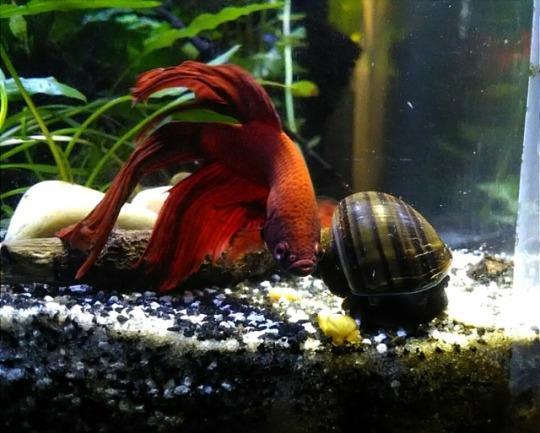
The territorial male betta is prone to attacking other males, often fighting to the death.
They can also turn on females after mating, especially if the couple has completed their bubble nest.
In addition, males can show aggression toward other fish species, especially if that fish is brightly colored or has long flowing fins. While they do not typically eat snails, they can nip at their appendages or go after smaller snails.
If you select a male betta, he should be the only betta in the tank. Never house two males together as they will fight.
Similarly, only house a single male and single female together long enough for them to breed. Then separate them.
If you are interested in this pairing, we have a detailed article about betta male and female living together.
Female bettas can live in a group of five or more in a betta sorority. In this arrangement, there may be some hierarchical squabbles; however, this aggression typically settles down.
Females are often more amenable to other tank mates.
Individual Temperaments
Even with every precaution taken, you still must consider the individual temperament of the fish.
Some fish have a calm personality that makes them perfect for a group living environment. Others will never tolerate another fish, or snail for that matter, in their territory.
It is best to have a backup betta tank available in case the species do not get along.
Size Matters
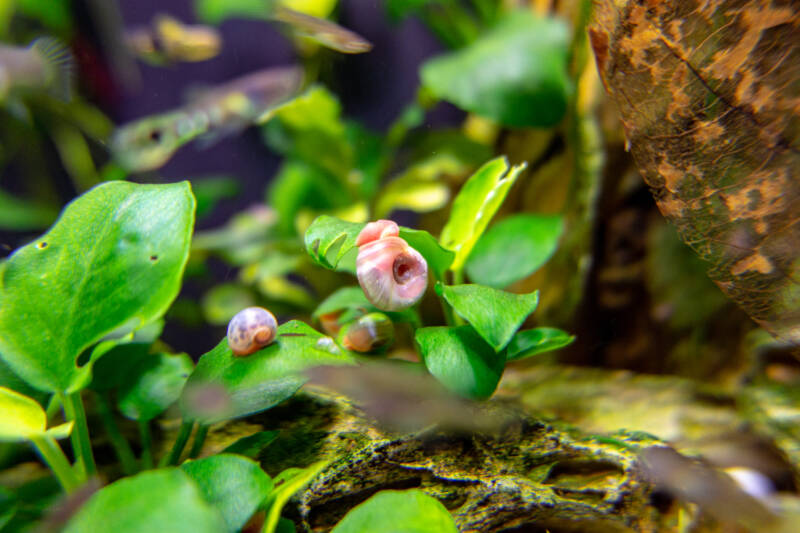
Betta fish have hearty appetites that can include small snails.
Larger snail species or specimens that are fully grown will be more difficult targets. Your fish may try to peck at them, but they have a better chance of being able to defend themselves.
Other great snails to consider are those with a “trap door,” or operculum, that they can quickly retreat behind should your betta get too curious.
Feed Your Fish Well
A well-fed betta is less likely to go after its tankmates to satisfy its hunger.
Feeding your betta two to four high-quality pellets twice a day and providing them with a variety of live/frozen/freeze dried foods will result in a fish that is not seeking its nutrients elsewhere.
Top Snail Choices for Living with a Betta
The following freshwater snails will pair nicely with your betta.
1. Nerite Snail (Neritina natalensis)
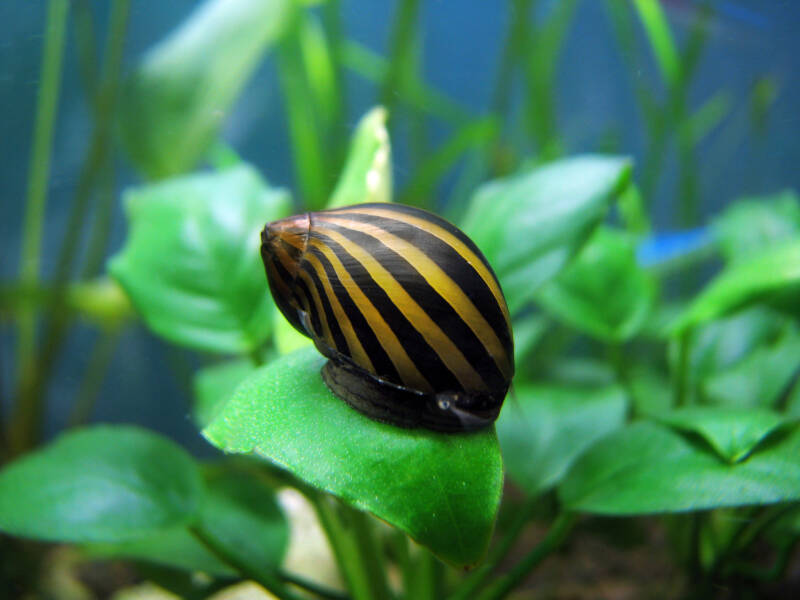
Wild nerite snails live in an amazing range of conditions, including fresh, marine, and brackish water. There are numerous color variations available, and they reach around an inch (2.5 cm) in length fully grown.
This gentle herbivore makes a dramatic difference in tank cleanliness. You can safely place them in planted tanks as their focus will be the algae.
Nerites love the same warm water as your betta. Keep the pH close to neutral or slightly above.
While nerite snails will breed and lay eggs in your freshwater aquarium, these eggs will not hatch as the larvae require brackish water to survive. Therefore, overpopulation is not an issue.
2. Assassin Snail (Clea helena)
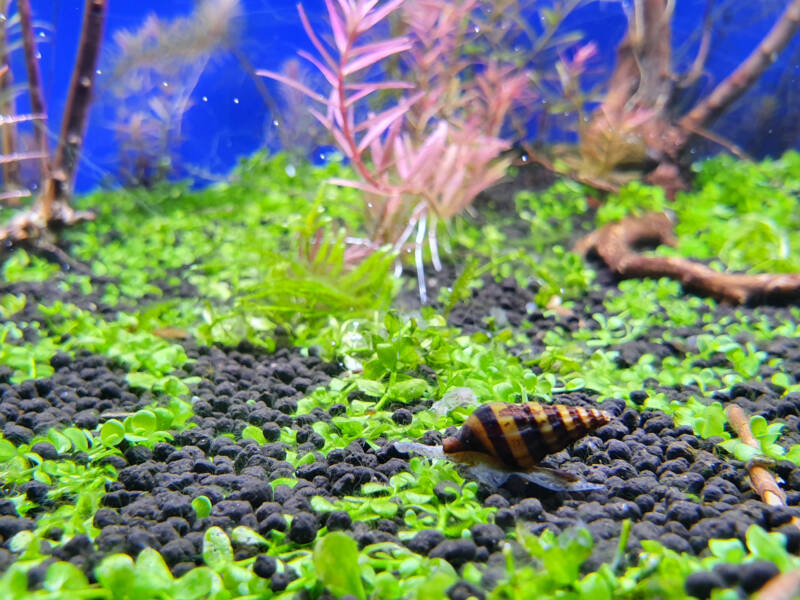
Frequently sold as a solution to snail overpopulation, the assassin snail is a useful home aquarium addition.
As an adult, they reach a length of around three inches (7.6 cm) and have vibrant yellow and brown/black colors.
They are sensitive to shifts in water parameters, so make every effort to keep them stable.
These carnivores are perfect for planted tanks as they have no interest in snacking on greens. However, once they run out of other snails to eat, you will need to feed them meaty foods.
They do not lay excessive numbers of eggs and so will not overrun your tank.
3. Malaysian Trumpet Snail/MTS (Melanoides tuberculata)
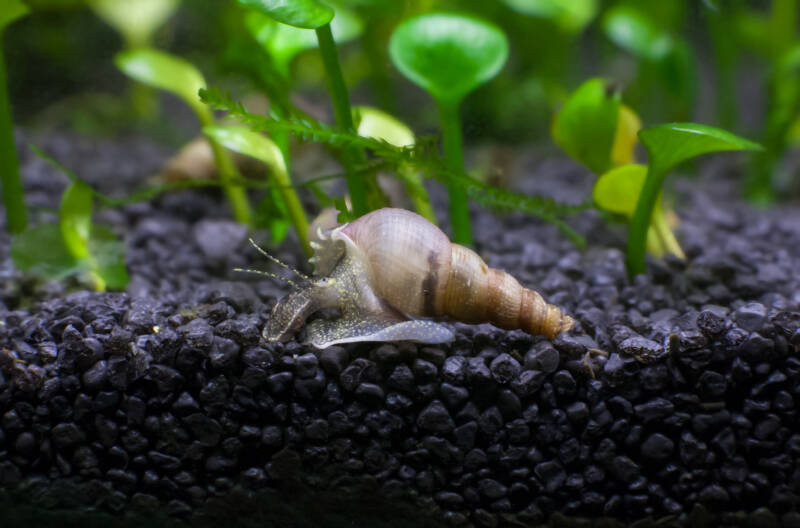
The Malaysian trumpet snail grows to a length of around one-quarter to one-half inches (0.6 to 1.3 cm).
These hardy snails are perfect for beginner aquarists, undemanding in their water and feeding needs, and help keep the tank clean through their scavenging.
They love to burrow into a sandy substrate, which keeps it aerated and prevents the buildup of toxic gasses.
Be aware that these snails are prolific and can easily overpopulate your tank if you do not control them. Too many snails in your tank will adversely impact the water conditions by increasing the bioload.
5. Mystery Snail (Pomacea diffusa)
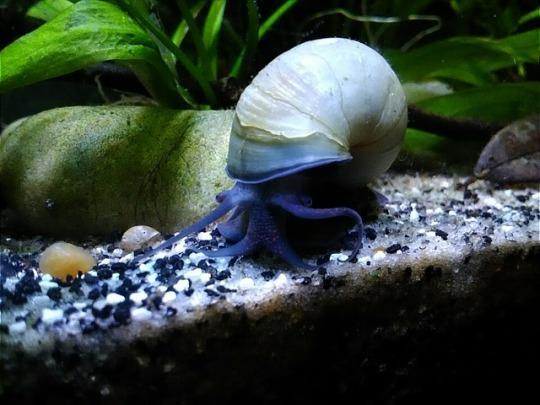
These snails are often mistaken for apple snails. Double check to make sure you are getting the species you wish. These omnivores will readily snack on algae and detritus in your tank.
Mystery snails are decently sized, reaching from just under two inches (4.5 cm) to 2.5 inches (6.5 cm) in length.
They require harder water than your betta may like and can benefit from the addition of calcium to the water.
These snails produce a hefty bio load if there are high numbers of them in a small tank. As they reproduce rather quickly and lay 100s of eggs, you should be active in population control.
4. Apple Snail (Pomacea bridgesii)

Apple snails are a peaceful species that bring a splash of color to your tank. While yellow or golden apple snails are quite common, you will also find black, pink, red, and blue variations.
Another species possessing an operculum, they can hide well when necessary. These snails grow to a respectable 2.5 inches (6.5 cm) in length.
This species is incredibly hardy and adaptable to a wide range of environments. They are considered an invasive species in several states, so check with your local Fish and Wildlife before importing one.
They reproduce rapidly, so you must attend to population control.
6. Pond Snail (Lymnaea stagnalis)

The ultra-hardy pond snail lives in a range of aquatic environments. Often considered a “pest snail,” they can show up in your tank uninvited, having hitchhiked in on an unquarantined plant or decoration.
They reach two inches (5 cm) in length as adults and have yellow-brown shells.
They readily devour algae and detritus. Take care when placing them in aquariums with live plants as these are also on the menu.
This species does not have an operculum as do other species on this list, which can make them vulnerable to nips from your betta.
They breed rapidly, so plan on population control measures.
7. Japanese Trapdoor Snail (Viviparus malleattus)
While the Japanese trapdoor snail is not the most colorful, they have several attributes that make them perfect for a betta tank. They reach an adult size of two inches (5 cm).
This long-lived species (think five to 10 years!) is incredibly hardy and can survive in an impressive range of water temperatures.
They excel at devouring algae in the tank while leaving your precious live plants alone. They do not breed as rapidly as other species, so the risk of them overpopulating your tank is lower.
Again, import laws will vary, so verify the eligibility of this snail with your local Fish and Wildlife.
Closing Thoughts
When searching for your betta’s tank mate, do not overlook the simple snail. These peaceful creatures are helpful in managing the balance of your tank, be it through algae control, detritus cleanup, or pest snail reduction.
They also add biodiversity to your betta tank and visual interest to multiple levels of the water column.
Share your story with us! What are your top snail choices for living with your betta fish?
